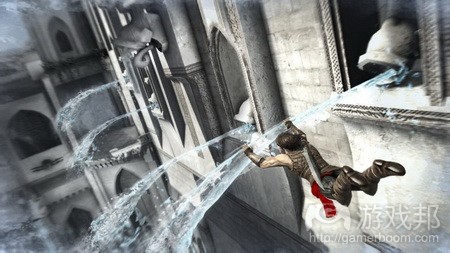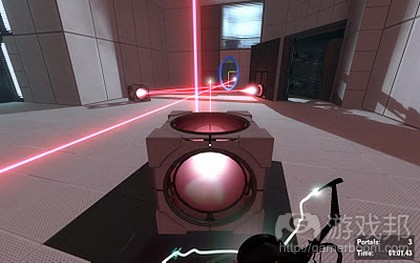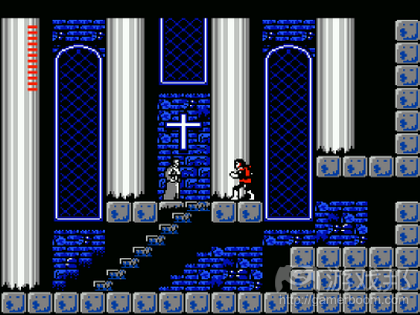开发者不应根据表面要素定义游戏体验
作者:Eric Schwarz
就衍生媒介角度来说,游戏世界存在众多独特的品牌和特性。综观新生作品及知名品牌,我们很容易就能发现它们的共同特点。《心灵杀手》谈论的是同自己内心邪念抗争的写作者。《边境之地》玩家要一边同来自外星世界的怪兽战斗,一边补充随机战利品。《使命召唤》主要涉及密集操作及高质量军械画面。《神鬼寓言》主要关于探索广阔的反应性世界,目睹主角的发展和成长。《极限滑雪》主要呈现极其陡峭的山峰及令人难以置信的滑雪技巧。
排除批评和美学元素不看,几乎所有游戏作品都能够通过简短语言进行描述,这主要涉及游戏的营销方式,玩家为何沉迷其中,及什么促使游戏脱颖而出——若你的游戏不够突出和独特,那么其机制多么出类拔萃完全无关紧要。行业竞争非常激烈,作品必须特色鲜明,如今市面上的游戏作品数不胜数,能够在短短几秒钟内向玩家呈现游戏的特色元素比整个制作投入过程重要很多。
图像、美学等元素是成功作品的组成要素,但我们鲜少从机制和结构角度描述游戏具体内容。我们通常所说的独特性主要体现在外观,而不是首先推动玩法机制的基本因素。即便在那些经验丰富的成功开发者看来,这些都主要归根于“感觉”,而不是什么对于关键要素的理解。本文主要谈论若干常被我们忽略的游戏要素,这些要素在定义游戏体验方面比任何品牌战术所起的作用都更突出。
成败状态
主流游戏行业有待重新修正的一个原则是成败状态的定义。几乎任何一款游戏都可以总结成:克服障碍,获得奖励。若是失败,我们会再次进行尝试,若顺利成功,我们将步入下个挑战或完成整款游戏。定义游戏构成要素对于我们把握这一媒介非常重要,几乎所有游戏都会涉及游戏成败的核心理念(游戏结束、重生、图像画面、仓库及角色前进);尽管如此,我们鲜少思考它们存在的原因,或者为什么它们会以这种形式呈现。在不清楚为什么多人模式游戏要基于积极获得尽可能多的碎片弹理念,或为什么RPG游戏要呈现一次性战利品的情况下我们也能够制作出杰出的游戏——我们将此当作前提条件。总体来说,我们过于依赖既有成败状态,所以当我们谈论偏离标准的游戏时,我们倾向将它们视作非游戏内容。
遗憾的是,和开发者一样,这种心理也同样得到玩家的认同。体验失败状态通常会让玩家倍感愤怒或疑惑。育碧的《波斯王子》(2008)尝试通过移除死亡结果改造此游戏系列的美学和玩法元素——虽然玩家依然需要克服特定挑战,以在游戏中前进,但失败不会导致玩家丧失原有进展。这能够解决众多玩家的抱怨,尤其是此系列更为传统的玩家——尽管《波斯王子》自几年前凭借《时之沙》重新问世以来,也是主要采用类似的无后果玩法(游戏邦注:尽管有相应的限度规定)。《故事中的故事》的《血径迷踪》也通过赋予不同玩法风格不同游戏结局大胆尝试此成败状态设置,而没有沿用原本的好坏结果模式——最终结果是游戏因大胆创新而备受赞誉,但很多玩家并不“理解”。
有趣的是,在多人游戏领域,成败状态遵循不同原则,偏离常规则再寻常不过。《Minecraft》就是没有设定明确成败状态的典型例子(甚至没有设定详细物理法则及支配游戏空间创建的规则机制),但这吸引玩家眼球主要是因为玩家更多将游戏看作社交体验,而不是传统游戏。但再次查看《Minecraft》你就会觉得游戏并没有像乍看之下的那般与众不同——MMO游戏多年来就已清楚证明,玩家并不喜欢进行直接竞争或在游戏中胜出,他们更喜欢占领他人的空间。当然,不同玩家会在不同游戏中收获不同的东西,但《Minecraft》开出这样的先河:无需将游戏内容同传统结构联系起来。就此来看,游戏放弃固有元素的做法(游戏邦注:即放弃将游戏同不必要的元素结合起来)要比其融入新元素更具创新性。就这方面来说,游戏能够获得成功实属常理之中。
思考玩家将如何在游戏中“胜出”或“失败”,或者这些词汇是否有任何含义对于游戏设计来说非常重要,这点我们毋庸置疑。死亡有很多同义词,促使暴力元素常会出现于不适合的游戏题材中,例如瞄准儿童的游戏作品。由于这点我们放弃很多游戏构思——有多少游戏真正围绕社交互动、纯粹的探索元素或创造自由及创新性设计具体内容?若设计师想要突出自己的游戏,着眼于“游戏结束”基本构成要素能够帮你找到很多突破口。
输入装置&游戏界面
关于输入设备、控制装置及游戏感觉,我们能够调整的游戏元素很多——从普通的按键设置及用户界面到摄像头距离和视野,再来就是以不同速度移动角色所需的极限操作,或是特定控制功能的兼容性(游戏邦注:例如,B是否总是代表“取消”,或者Back按键有时是否有更多操作含义?)。
在创建这些内容前,把握相应输入方式会给玩法带来什么影响非常重要,尤其是在大致界面框架中。虽然无法一一详述,但下列是若干我们常会看到的形式,及它们带给玩法的含义:
1. 第一人称视角。控制装置的常规设置通常会根据最大型射手的标准而发生改变(长久以来,因飞行模拟器惯例,反向控制装置已变成标准模式),但这些游戏几乎主要依靠权衡定位和正面接触情况——就射击游戏来说,这也许就是边校准枪支边躲闪子弹,而在多人游戏中,玩家同各物体的活动也能够呈现相同模式。尽管存在外观差异,但操作方式几乎完全相同。有时有限视角也能够发挥显著作用。
2. 第三人称视角(3D/过肩镜头)。通常第三人称游戏更多着眼于空间的导航。由于玩家的空间和情境意识不再受到角色视野的限制,挑战鲜少依赖于具体目标的辨别及指示,而更多依靠角色的引导——复杂闪躲、滚动或跳跃等操作很难在第三人称游戏中实现,但在玩家能够查看角色移动方式的情况下就非常适合。
3. 横向卷轴模式。虽然第三人称游戏主要基于通过定位躲闪障碍,但横向卷轴更多涉及控制装置的掌握及对整个游戏空间的把握。有限视角意味着游戏的挑战不是体现在,基于微观视角操纵角色(要向前躲闪,还是左前方?),而是在于执行构成更大操作链条的系列复杂输入操作(从平台X跳至Y,躲闪,射击,躲闪,跳跃,下降等,《Contra》就是典型例子)。在某些情况下,游戏焦点也会变成浏览一般关卡空间和子关卡,这在《银河战士》和《塞尔达》中一览无遗。
4. 等角/点击。这类游戏通常只出现在点击式或触屏式控制装置中,这不无道理——在多数情况中,挑战归根结底就是设备的速度&准确度及复杂输入组合的协调性(如《星际争霸》),或管理其他界面无法实现的大型任务,虽然多数游戏主要基于游戏玩家控制某存在限制因素的角色的模式,但等角游戏通常着眼于玩家自己的灵活度。显然,基于此视角进行体验的游戏规模会更大。
尽管如此,这也存在例外情况,还有些游戏是兼容二者——例如,有些策略游戏和侧边滚动模式相差不大,后者的难度主要体现在管理复杂输入装置(正确定时及排序等);赛车游戏也和3D平台游戏大同小异,平台游戏的主要目标是在回避障碍(汽车或滚动岩石等)的同时引导角色前进。但留心视角和输入装置给玩法潜力带来的影响能够帮助我们在设计过程中扬长避短。《镜之边缘》或《Fallout: New Vegas》之类的游戏充分说明,除非你的关卡设计和玩法能够体现输入装置和视角,否则你就会陷入困境(在这些例子中是过于复杂的导航操作)。但《超级银河战士》就非常成功,因为游戏巧妙运用其界面的内在优势,再来就是《传送门》,因为其入口给玩家创造新视角。
玩法机制&结构
从广泛意义来说,游戏设计存在两种模式——坚持瞄准平衡机制,掌握必要元素,创造纯玩法体验,或是管理各机制的交互作用,让这些机制的平衡关系弥补单个机制本身的缺陷。二者不存在优劣之分,虽然小型游戏也许更适合前种模式,能够以此避免功能蔓延和膨胀;定义和管理组成游戏的机制是把握其运作方式及原因的关键。
搭载传统掌机(如Atari、NES/SNES、Master System/Genesis)的游戏及新型手机游戏(iPhone/Android)通常属于前种类型,这类游戏的设计通常专注于雕琢游戏构思,只添加能够维持体验新鲜感的内容。例如,《割绳子》从机制角度来看也许非常简单,但游戏呈现的挑战及变化分数机制重新塑造这些机制在新背景中的作用,从而维持内容的趣味性。与此同时,《刺猬索尼克》则将焦点放在重玩价值和高速运作,游戏关卡会奖励快速完成任务的玩家,熟练玩家能够在游戏中更快升级。这些游戏都不是特别有“深度”,但它们能够给玩家留下不可磨灭的印象,因为它们的核心机制非常精致。
相反,很多游戏则选择创建广泛内容,融合众多机制,从中给玩家创造乐趣。虽然这主要适用于大型游戏,如《上古卷轴》系列,但很多小型游戏也基于此交互模式。想想《使命召唤》如何要求玩家管理健康、弹药数量、基于运动和曝光的风险/奖励、加载时间,甚至是 killstreak奖励的运用,从而获得持续进展,进行重新定位,确保游戏紧凑进行。我们有时也许会将其看作“愚蠢的射手”,但真实情况是有很多游戏内容我们都没来得及进行思考。《使命召唤》若干杰出机制(游戏邦注:例如前面提到的killstreak奖励)之所以表现突出是因为它们同持续运作的风险/奖励机制紧密集合,无论是收集奖励还是使用奖励。
多数游戏都介于二者之间。真实的游戏制作情形是,虽然从理论来看,列举和陈述具体玩法元素很简单,但要真正将其转化成有趣的内容就需要花费数个月进行调整,且就现代制作效果来说,开发者鲜少能有足够资源完善他们的机制。但机制间的互动作用通常就足以弥补其中的缺陷,致使玩家愿意接纳游戏存在的众多平衡问题或粗浅机制,前提是交互内容足够有趣且富有沉浸性。膨胀的游戏会让玩家持续遭遇平衡问题或结尾节奏问题,进而踌躇不前。
总结
我们很容易将游戏的成功归功于美学元素,因为作为游戏粉丝,我们很容易掌握玩家的想法,有时就连经验丰富的设计师也会将目光锁定在表面元素。尽管如此,游戏设计既涉及创造有趣机制,把握控制方案给挑战结构带来的影响,也需要结合叙述和艺术风格,或通过微妙声音线索逐步提高关卡的紧张感,但就像音乐知识理论对谱曲来说很重要一样,正确把握特定游戏元素如何影响游戏运作能够促使我们创作出更具沉浸性的体验。
总而言之,我希望随着玩家和游戏设计师游戏知识水平的提高,以及剖析游戏内涵词汇的增多,我们对于“游戏涉及什么元素”这一问题的回答也会发生改变。游戏构思非常重要,但过多着眼于题材和图像,这会让我们降低自身表达的清晰度和准确度,同时也会妨碍我们正确把握游戏构成要素。(本文为游戏邦/gamerboom.com编译,拒绝任何不保留版权的转载,如需转载请联系:游戏邦)
What is Your Game About?
by Eric Schwarz
For such a derivative medium, the gaming world has a lot of distinctive brands and properites. Glancing over a lot of newer releases and big-name franchises, it’s very easy to identify the unique qualities of all of them. Alan Wake is about a writer dealing with his own inner demons made real. Borderlands is about fighting monsters on an alien world while feeding the random loot demon. Call of Duty is about intense action and high-grade military gun porn. Fable is about exploring a large, reactive world and watching your hero grow and develop. SSX is about impossibly steep mountains and even more impossible snowboard tricks.
Almost every single gaming franchise of any note can be easily described in a few short words, as far as brand and aesthetic go, and this is how games are marketed, why players become attached to them, and what generally separates successes from failures – if your game isn’t memorable and distinct, it doesn’t matter how good it is mechanically. Competition is just too steep to not stand out, and there are so many games crowding the marketplace that being able to communicate to players exactly what a game’s strengths are in a manner of seconds is often more important than all the work put into the game itself.
However, while questions about image, aesthetic and so on are integral to the success of a game, we rarely take the time to address what a game is about mechanically and structurally. Distinctiveness is something we express in terms of looks, not in terms of the fundamentals that actually drive the gameplay experience in the first place. Even among experienced and successful developers, much of this comes down to “feel” rather than any particular critical understanding. In this article I’d like to take the time to draw attention to a few aspects of games that we don’t always think about, but have a bigger say in defining our experiences than all the branding in the world.
Success and Failure States
One rule that has yet to be seriously rewritten in the mainstream games industry, beyond more than a few experiments, is what the terms of success and failure are. Almost any single game can be summed up as: overcome obstacles for rewards. If we fail, we try again, and if we succeed, we typically move on to the next challenge or complete the game. This definiton of what constitutes a game is so fundamental to our understanding of the medium that key ideas tied into success and failure – game over, respawning, cinematics, inventory, character progression – are all expected in just about every game; despite this, we rarely stop to think about why they are there, or why they take the forms they do. It’s possible to create great games without even knowing why a multiplayer mode should revolve around attaining the greatest number of frags, or why an RPG should feature disposable loot – we just take these as givens. More generally, our reliance on success and failure states is so great that even when we talk about games that deviate from the norms, we tend to think of them as non-games.
Unfortunately, this mentality can be backed up by players as much as by developers, and experiments with failure states are often met with anger or confusion. Ubisoft’s Prince of Persia (2008) attempted to reinvent both the aesthetic and gameplay of the series by effectively removing the consequence from death – though players would always have to overcome specific challenges to proceed, failing would not result in lost progress. This was enough to set off a torrent of complaints from many gamers, especially the more traditional fans of the series – even though Prince of Persia, since its revival with The Sands of Time years before, had featured this exact same consequence-free gameplay, albeit with a limit imposed. Tale of Tales’ The Path also experimented rather boldly with the idea of failure and success states by providing different endings for different play-styles, without sticking to obvious good and bad outcomes – the result was a game that was praised for its innovation, but many players simply did not “get.”
Interestingly, in the multiplayer space, failure and success states play by very different rules, and deviation from the norm is common. Minecraft is an obvious example with no clear success or failure (or even strict rules save for the laws of physics and crafting system that govern the game world), but this is appealing primarily because players enjoy the game more as a social experience than as a traditional game. However, Minecraft is not as different at second glance as it initially appears – MMO games have shown for years that players are often less interested in direct competition and winning as they are with simply occupying a space with others. Different players get different things out of different games, of course, but Minecraft scratches a very particular itch without feeling the need to tie itself to more traditional structure. In this sense it is not so much innovative for what it does so much as what it doesn’t do – fetter itself with unnecessary baggage. In this light, its success is easier to comprehend.
Considering exactly how a game will be “won” or “lost”, or whether such terms will have any meaning at all, is something fundamental to design that we almost never think to question. Even death is so much a synonym that violence can often work its way into games where it may be wholly inappropriate, such as titles aimed at children. Many game concepts are never even considered because of this – how many titles do we see that seriously build themselves around social interaction, exploration for exploration’s sake, or freeform building and creation? If designers (and publishers) want to distinguish their games, looking to and toying with the very basics of what constitutes “game over” opens many doors.
Input & Interface
There are hundreds of different factors about a game that can be fine-tuned when it comes to input, controls and game feel – from more general things like button layout and user interface, to camera distance and field of view, to smaller details like the threshold of action required to move a character at different speeds, or consistency of certain control functions (should B always cancel, or does the Back button make more sense sometimes?).
Understanding how these methods of input affect gameplay is crucial to actually building it in the first place, especially in the broad strokes of interface. Though I don’t go into each and every one, below are some of the most common forms we see, as well as their implications on gameplay:
1. First-person perspective. Conventions for controls tend to vary based on standards set by the biggest shooter (for a long time inverted controls were standard due to the legacy of flight simulators), but these games almost always rely upon striking some sort of balance between positioning and facing – in the case of a shooter, it might be aiming a gun while dodging bullets, while in a role-playing game, interacting with objects may take on the same function. Despite the cosmetic differences, the method of action is effectively identical. Sometimes, the limited field of view can be used to interesting effect, as well.
2. Third-person perspective (3D/over the shoulder). Generally third-person games place more emphasis on navigating an environment. Due to the fact that the player’s spatial and situational awareness are no longer hampered by what is immediately visible by the avatar, instead the challenge relies less in identifying and pointing at targets, and more on piloting the avatar – complex dodges, rolls, jumps and so on are almost always impossible to pull off effectively in first-person games, but work just fine when the player can see how their avatar moves.
3. Side-scroller. Whereas third-person games usually rely on dodging obstacles through positioning, side-scrollers tend to be much more about mastery of controls and understanding whole game worlds. The limited (usually 2D) perspective means that challenge is not about navigating on a micro-level (do I dodge forward or forward-left?), but rather about performing complex sequences of input that form larger chains of action (jump from platform X to Y, duck, shoot, duck, jump down, etc. – see Contra for a classic example). In some cases, the focus also turns to navigation of an overworld environment and sub-levels, especially common in the Metroid and Zelda games.
4. Isometric/point and click. These types of games are only common on devices with pointer-style controls or touchscreens, and with good reason – in almost all cases the challenge comes down to speed and precision of the pointer device, coordination of complex input combinations (as in the case of strategy games like StarCraft) or managing large tasks that would be impossible in any other interface (such as ordering groups of soldiers around a map) – whereas most games put the emphasis on the player’s ability to manipulate an avatar held by certain constraints, isometric games usually emphasize the player’s own dexterity. Necessarily, games played from this perspective are generally larger-scale, although of course there are exceptions.
Granted, there are always exceptions, and there is also a lot of overlap – some strategy games are not so different from side-scrollers, for instance, in that much of the difficulty comes in managing difficult chains of input (correct timing, sequence, etc.), and a racing game is not unlike a 3D platform game in that the goal is to avoid obstacles (cars or, say, rolling boulders) while piloting an avatar. However, paying particular attention to the effect perspective and input mechanism have on potential for gameplay can help emphasize strengths while minimizing weaknesses in design. Games like Mirror’s Edge or Fallout: New Vegas demonstrate that unless your level design and gameplay accommodate input and perspective, you’re going to run into problems (overly difficult navigation, in their case), while Super Metroid is successful precisely because it so expertly builds itself around the inherent strengths of its interface, and Portal because its portals literally open new perspectives for the player.
Gameplay Systems & Structure
There are generally two approaches to game design on a broad level – go for a very tight, well-balanced, focused mechanic and stick to it, making sure to master the essentials and create a pure gameplay experience, or try to manage the interactions between multiple systems (mini-games in themselves) and make sure that the balance between all of these is able to make up for the general deficiency in the individual mechanics. One isn’t necessarily better than the other, although smaller games may be suited to the former approach to avoid feature creep and bloat; defining and managing the systems that make up a game is crucial to understanding how or why something works, or doesn’t.
Both the games on older consoles (Atari, NES/SNES, Master System/Genesis, etc.) and the newer mobile games (iPhone/Android) tend to fall into the former category, with games whose designs effectively polish a single idea to a mirror finish, adding only what’s needed to keep the experience fresh for its intended duration. Cut the Rope might be absurdly simple mechanically, for instance, but the challenges it presents and variable scoring system repurpose those mechanics in new contexts to keep things interesting. Meanwhile, Sonic the Hedgehog puts heavy focus on replayability and speed-running, featuring levels that reward fast completion and facilitate it for players who are skilled enough. Neither of these games are especially “deep”, but they are able to leave lasting impressions precisely because their core mechanics are so polished.
Conversely, many games opt for sheer size and the interaction of many mechanics to produce their fun. Although applicable to the largest games, like The Elder Scrolls series, many smaller-scale games also rely upon this interplay. Consider how Call of Duty requires players manage health, ammo capacity, risk/reward in terms of movement and exposure, reload time, and even killstreak reward use in order to force constant movement, repositioning, and ensures things are always tense. We might think of it as a “mindless shooter” at times, but the truth of the matter is there is a lot going on that we never even stop to think about. Some of the most successful mechanics in Call of Duty, such as the aforementioned killstreak rewards, work so well precisely because they tie into the continual risk/reward systems at play, whether that’s in accumulating them (through either consistent or risky play), or in using them (pick the wrong time and the reward is wasted).
Most games are going to sit somewhere in the middle. The reality of game creation is that while on paper it’s easy to specify and articulate many aspects of gameplay, actually turning it into something fun requires months of tweaking, and with modern production values being what they are, developers rarely have the resources to perfect their mechanics. The interplay between mechanics is very often enough to make up the difference, however, so much so that players are willing to forgive a lot of balance problems or shallow mechanics if the interactions are interesting and addictive enough. A bloated or anemic game will give players pause far more than one with balance issues or endgame pacing concerns.
Closing Thoughts
We too easily attribute the success of games to the aesthetics that surround them – and this is often very tempting to do, because as fans of games we tend to see what fans see, and even experienced designers can sometimes fixate on the surface elements. Granted, game design is as much about creating interesting mechanics and understanding the impact of control scheme on challenge construction, as it is about being able to unite narrative and art style, or create the perfect rise in tension through a game level by using subtle audio cues, but just as knowledge of music theory is important to composition, being able to understand exactly how and why a particular element of a game influences how it plays can allow for the crafting of more compelling experiences.
More broadly, I also hope that, as gamers and game creators develop critically and intellectually, and the vocabulary for understanding games grows, the answers we give to the question “what is your game about?” will change. This might sound a bit game design 101, but even so it can be easy to get caught up in the minutia and miss out on the fundamentals driving a game. Ideas are all well and good, but in focusing too much on genre and on image, we restrict the articulation and precision of our expression, as well as dampen our understanding of what constitutes a game in the first place.(Source:gamasutra)










































 闽公网安备35020302001549号
闽公网安备35020302001549号